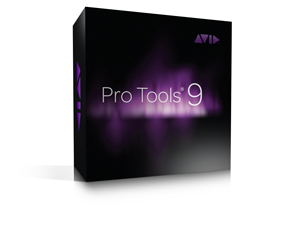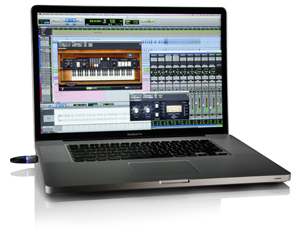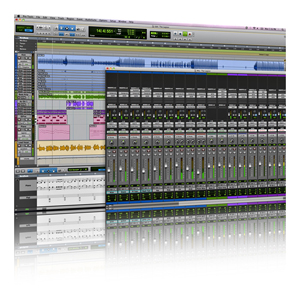Pro Tools 9: Do You Need It? We Ask The Early Adopters
In the first week of November, just as they began shipping an unprecedented new product called Pro Tools|HD Native, Avid made an even more stunning announcement: They would break free of Digidesign’s mold by demolishing the distinctions between HD and LE software to offer one platform – Pro Tools 9. For the first time, this software-based version of Pro Tools allows all users access to a full feature set, whether they run the program with Avid hardware, a third-party interface or even a laptop’s built-in soundcard.
“Digidesign was a great brand,” said Tony Cariddi, Pro Segment Marketing Manager for Avid, when we spoke to him for this piece, “but they would have never done something as bold as this.”
That statement is probably true. Long-time Pro Tools users, accustomed to an old parent brand that routinely met user requests only half-way, demonstrated shock and a welcome sense of disbelief when Pro Tools 9 was announced.
To those who aren’t familiar with the limitations Pro Tools LE imposed on laptop-lovers and entry-level users, this may sound like small news. For the rest of us, it bordered on earth-shaking.
It’s been two weeks since the instant upgrade became available for download. As this game-changing release began making it out to the market, we reached out to some of the earliest adopters in NYC. “Does it live up to the hype” we asked, “And what does it say about where the industry has been, and where it’s going?”
Producer/engineer Allen Farmelo (The Cinematic Orchestra, The Loom, Jonah Smith) says he was “skeptical at first”, but he didn’t mince words when it came down to the impact of Pro Tools 9: “It’s really the most significant upgrade of Pro Tools ever.”
So what’s the big deal? For starters, Avid decided to reverse course when they embarked on the Pro Tools rebrand. One of the first orders of business was to actively solicit user feedback through the online market research application IdeaScale. Although it took some time to turn a ship this big, they listened. Gripe number one, said Cariddi, was the absence of Auto Delay Compensation on LE systems. Farmelo weighed in again here:
“I am thrilled that the younger generation of folks getting into Pro Tools aren’t going to have to grapple with the unfathomable out-of-phase junk that was messing up so many LE-based projects. Quite literally, the world will have fewer f*d-up records because ADC is being included.”
For some users, it’s the little things that make a big difference. Producer/engineer Fabrice “Fab” Dupont (Les Nubians, Brazillian Girls, Shakira/Freshlyground) of NYC’s Flux Studios saw one of his long-standing requests addressed: “There’s a Key Command for ‘New Playlist’ and ‘Duplicate Playlist” now! I’m holding back tears of joy.” Farmelo adds, “Want to bus the snare out to an Aux for some parallel work? One click. Want to create a cue mix from a group of tracks? Boom. One click.“
It’s easy to recommend the reduced-cost upgrade to many current Pro Tools users. With crossgrades starting as low as $250, LE users can unleash features and track counts that were formerly restricted to HD, including multi-track Beat Detective, Digi Translator, MP3 Bounces, and ADC — all the big requests they’ve been asking for.
At first glance, Pro Tools 9 seems like it best serves users upgrading from LE systems, but there is one huge benefit for users who already own an HD system.
Producer/guitarist Eric Ambel (Kasey Anderson, The Yayhoos, The Bottle Rockets), of Brooklyn’s Cowboy Technical Services, explains, “I just ran a big 96k session on my MacBook with no interface and no problem. That was hot! The open model of 9 can only help.”
Dupont likened the new portability of HD sessions to “Science Fiction ” and told us about the stability he’s experienced with internal soundcards and 3rd party systems:
“Yes, it works great. I’ve run it with built in headphone jack, a Metric Halo box, a SoundDevices box, an RME box, some non-descript iffy USB-to-AES device, a Digi003 and an MBox micro. They all worked like a charm. Switching back-and-forth, the mixes came up just right. I even ran it from the optical digital out of my Mac Pro tower that has the HD4 in it. It felt kind of surreal.”
Avid’s recent developments will no doubt win back favor with formerly frustrated Pro Tools users, some of whom may have switched to other platforms. Producer/engineer John Goodmanson (Los Campesinos, The Blood Brothers, Death Cab For Cutie) had been using Logic, but says of Avid and Pro Tools, the new “third party hardware and EUCON support is how they got me back.”
The initial feedback we received for this release has been so generally positive, that it’s difficult to craft an article that sounds balanced. So what are the cons?
Some hardware-dependent features like TDM plug-ins and near-zero latency are only available to those running HD systems. Producers of audiobooks and podcasts may still feel limited by the lack of a simple alternative to a “Real-Time Bounce” option. And, once the post-release promotions end, a MSRP of $600 for a software-only release may muscle out a future crop of entry-level recordists.
And one caveat to some HD users: although Pro Tools 9 is a great for producers who want to take their sessions on the go, what about travelers who own a permanently installed studio system? Pro Tools 9 is protected by the handy iLok protocol, but buyers are allowed only one authorization per purchase. This means that if you take your iLok on the road, you’re taking your ability to run Pro Tools with you… Unless you purchase a second authorization.
This reviewer can imagine a few logical compromises that would easily resolve this issue, but as of press time, the only course of action for traveling producers who run commercial studios is a duplicate purchase at the full retail price.
Lastly, some owners of commercial studios may feel pressure to purchase an upgrade that may not reap them direct benefits. Will Schillinger of Pilot Recording Studios, who recently upgraded to Pro Tools 8, said he may decide to purchase an additional update just to keep his room up-to-date. In a way, “they still have us by the short hairs” he says.
So is it worth the buy? If you’re an LE/M-Powered user without all the extra toolkits, or if you want to work on full-blown HD sessions anywhere, anytime, the answer is a resounding yes. It’s a fairly inexpensive upgrade that offers tremendous value.
We asked the people at Avid what we can expect from future releases. Although they wouldn’t comment on specifics, they reminded us that user feedback drove the changes under the hood in Pro Tools 9 and that they were committed to “staying more open, engaging the users, and paying close attention to new feature requests on IdeaScale.”
Cariddi also mentioned that we could look forward to more and more seamless integration with Avid’s video and live sound platforms. “We anticipate those markets being blurred, and we intend to build bridges in video, audio and live sound.” Fans of Pro Tools’ simple, powerful interface can take heart knowing that Avid has breathed new life into the platform, restoring the long-time, industry-leading DAW with a real sense of innovation and openness to future development.
Click for more on Pro Tools 9 and to upgrade today.
Justin Colletti is a Brooklyn-based audio engineer and music producer who’s worked with Hotels, DeLeon, Soundpool, Team Genius and Monocle, as well as clients such as Nintendo, JDub and Blue Note Records. Visit him at http://www.justincolletti.com.
Please note: When you buy products through links on this page, we may earn an affiliate commission.










brooklynguy
December 2, 2010 at 7:58 pm (14 years ago)Useful article! Thanks!
TimCtheFilmGuy
December 2, 2010 at 8:30 pm (14 years ago)sounds like the finally caught up to where Nuendo was 3 years ago
Matt Verzola
December 2, 2010 at 8:52 pm (14 years ago)I didn’t know about the hotkeys for New/Duplicate Playlist. That’s really handy. What hotkey is Farmello talking about when he says, “Want to bus the snare out to an Aux for some parallel work? One click. Want to create a cue mix from a group of tracks? Boom. One click.“
Non-Realtime bounce in the next version would be reeeaaalllly nice (and overdue).
Joe
December 2, 2010 at 9:45 pm (14 years ago)PT 9 still requires a toolkit for surround mixing…boo!.hiss!
Fourminutes
December 2, 2010 at 11:26 pm (14 years ago)game changer? more like Avid playing catch-up with other DAWs that have had these features for years.
Kudos
January 13, 2011 at 11:55 pm (14 years ago)Hi, that’s a fair argument.
I think it’s also fair say that when the market-leader finally unlocks features that were previously offered by its competitors at lower price point, they’ve effectively “changed the game”. Dramatically.
So, you’re both right.
JC
January 14, 2011 at 12:00 am (14 years ago)Hi Matt,
This actually refers to a function of setting up sends via the mouse, rather than a new key command. They’ve really streamlined some of the setup and routing functions. You’ll see what I mean once you get a chance to click around in there.
Philip Rudy
February 22, 2015 at 8:55 pm (10 years ago)The just announced pro tools 12 over at http://www.pro-tools-expert.com/